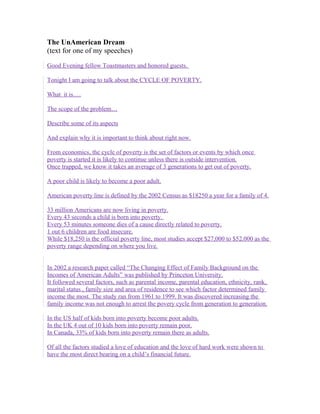
The UnAmerican Dream2015
- 1. The UnAmerican Dream (text for one of my speeches) Good Evening fellow Toastmasters and honored guests. Tonight I am going to talk about the CYCLE OF POVERTY. What it is…. The scope of the problem… Describe some of its aspects And explain why it is important to think about right now. From economics, the cycle of poverty is the set of factors or events by which once poverty is started it is likely to continue unless there is outside intervention. Once trapped, we know it takes an average of 3 generations to get out of poverty. A poor child is likely to become a poor adult. American poverty line is defined by the 2002 Census as $18250 a year for a family of 4. 33 million Americans are now living in poverty. Every 43 seconds a child is born into poverty. Every 53 minutes someone dies of a cause directly related to poverty. 1 out 6 children are food insecure. While $18,250 is the official poverty line, most studies accept $27,000 to $52.000 as the poverty range depending on where you live. In 2002 a research paper called “The Changing Effect of Family Background on the Incomes of American Adults” was published by Princeton University. It followed several factors, such as parental income, parental education, ethnicity, rank, marital status , family size and area of residence to see which factor determined family income the most. The study ran from 1961 to 1999. It was discovered increasing the family income was not enough to arrest the povery cycle from generation to generation. In the US half of kids born into poverty become poor adults. In the UK 4 out of 10 kids born into poverty remain poor. In Canada, 33% of kids born into poverty remain there as adults. Of all the factors studied a love of education and the love of hard work were shown to have the most direct bearing on a child’s financial future.
- 2. Speaking of education, 2 interesting trends emerged Schools with lower performing students tend to hire less qualified, less experienced teachers. The net of which is a less educated adult. Also the practice of tracking, has become the norm in recent years. Lower performing students are grouped together and separated from their higher achieving classmates. The skill levels are kept separate to facilitate better learning. The problem is, the lower performing students have a separate and often inferior curriculum. These two trends result in actually perpetuating rather than fixing the poverty cycle. In her book “A Framework for Understanding Poverty “Ruby Payne argues that each economic class in the US is unique onto itself with its own rules and values. The culture of the poor is one where you live for today because tomorrow is not promised to you. The poor are less likely to save their money or invest it. She argues that a learned helplessness gets passed down from generation to generation. A recent study from New Zealand suggests if a person experiences 7 or more life shocks. It is the same as having been born poor. Such life shocks include: Divorce Incarceration Foreclosure Illness Drop in income Damage to home Eviction Unplanned Pregnancy Bankruptcy court ordered fines or Community Service Job Loss 3 or more months unemployed Victim of Violence We live in a time of Life Shocks that can easily move us into the poverty cycle. Now is the time to learn all we can about poverty and decide as a nation and as individuals what we must do to break the cycle of poverty for our neighbors and ourselves.